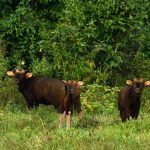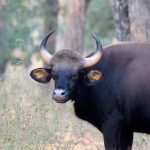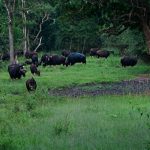Gaurs of Phansad Wildlife Sanctuary
The Indian Gaur Bos gaurus is the world’s largest and tallest wild bovine having males often weighing 1000–1500 kg and females 700–1000 kg. They reach a height of about 165–220 cm. Males are about one-fourth larger and heavier than females. Gaurs are among the largest land animals, surpassed only by the elephants, rhinos, hippopotamus, and giraffes. The Indian Gaur is listed as schedule I species in the Wildlife Protection Act 1972 and has been assessed as
Vulnerable on the Red List.
Gaur inhabits a wide variety of habitats ranging from tropical wet, semi-evergreen and bamboo forests, tropical moist deciduous to tropical dry deciduous forests. It is distributed in southern and southeastern Asia, from India to peninsular Malaysia. Approximately, 85% of its current global population occurs in India. Major population of Gaur is found in three distinct regions: southwestern India, central India, and northeastern India. From its reported distribution in the past, the species has experienced dramatic range reductions with present population surviving in isolated forested patches. Historically, the southwestern Indian population of Gaur ranged throughout the whole Western Ghats mountain range, from Kerala to the Dangs in Gujarat, however, the current northern limit of this population appears to be in Mahabaleshwar, Maharashtra. Apart from a few anecdotal reports there are no recent confirmed records of occurrence of Gaur
from north of Mahabaleshwar.
Phansad Wildlife Sanctuary (PWS; 18.4230N & 72.9470E) is situated on the western coast of Maharashtra in the Roha and Murud talukas of Raigad District. The Sanctuary was established in 1986 and spreads about 52.6sq.km in area. The Sanctuary area is mostly covered with southern moist mixed deciduous forest. It is also ranked among one of the highest conservation priority zones of Maharashtra (Rodgers & Panwar 1998). The landscape of PWS is virtually isolated from the mountains of the Western Ghats and if any wildlife corridor between these two regions exists, it is currently unknown.
In August 2018, locals of the Supegaon Village (18.4260 N & 72.9500 E), which is located in the Sanctuary, reported to us about the presence of Gaur within the Sanctuary. To confirm their presence, we conducted an opportunistic survey on old and newly formed paths and trails in September 2018 near the Supegaon area of the Sanctuary. During the survey, we found footprints, dung, and paddy crop damage showing signs of Gaurs near the sacred grove of Supegaon (18.4300N & 72.9550E); however, we couldn’t sight or photograph any Gaur. On 15 September 2019, again during a survey, we sighted a herd of Gaur near the sacred grove at about 06.10h and photographed it. The herd was of nine individuals, consisting two juveniles, two subadults and five adults. The herd was grazing in the paddy field adjacent to the forest, however, sensing the presence of unknown beings, the herd ran into the forest.
This is the first photographic records of Gaur in this Sanctuary and it confirms their presence. Apart from the recent sightings of the local villagers, no occurrence of Gaur was reported or documented earlier from the Sanctuary. Whether the herd sighted here is a local herd or a migrated one from somewhere else is currently unknown. There is a need to conduct a genetic study to find out the source of this population, which may eventually help in finding the plausible corridor that these animals might have followed.
The Indian Gaurs are threatened with habitat loss and fragmentation. Diseases, particularly rinderpest, anthrax, and foot & mouth diseases transmitted by domestic cattle are potentially serious threats. Some animals also die from ingestion of agrochemicals and human response when wandering into farmland and villages. These could be significant for already isolated and reduced populations.
This herd was found near the Supegaon Village and was also observed feeding on paddy crops. Hence, cattle-borne diseases and ingestion of agrochemicals could be potential threats to this population. Apart from this, inbreeding due to habitat fragmentation and human-wildlife interactions are some potential threats. These findings warrant the need of long term monitoring of this population in the future. Further studies on movement patterns, population genetic studies, any human wildlife conflicts, and habitat use in PWS are needed.



